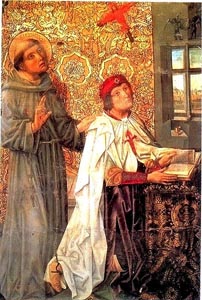|
The Order
of Santiago was founded in the 12th century under the patronage of
Galicia and Spain, Saint James the Greater. It was under his
patronage that the Christians of those two locations began the fight
in the 9th century against the Muslims in the Iberian Peninsula. In
fact, this order helped to drive the Muslims from the peninsula. Part
of their responsibilities included resettling land reclaimed from the Muslims.
As was
common in knightly orders of the day, the Order of Santiago had a
character similar to a religious order. Unlike other orders, however,
that followed the severe rule of the Benedictines of Cîteaux,
the Order of Santiago adopted the less strict rule of the Canons of
St. Augustine. The order is both hospitaller and military, like the
Knights of Malta. In addition to monasteries, they also operated at
least one leper hospital.
The Order
of Santiago was recognized as religious by Pope Alexander III, whose
Bull of in 1175 was later confirmed by more than twenty of his
successors. These pontifical acts gave them all the special
privileges and exemptions of monastic orders. They also enjoyed the
support of King Ferdinand of Aragón who had granted it title
to the original headquarters in 1171. Their headquarters later moved
from Caceres to Ucles after the loss of Caceres, the castle at Ucles
having been granted by King Alfonso IX of Castille. They were granted
extensive properties in Portugal, including the town of Palmella, and
later acquired properties in France, Italy, Palestine, Carinthia,
Hungary and England (Desmond Seward. The
Monks of War. Eyre Methuen. 1972.). Like
the Templars and Hospitallers, they quickly gained much feudal power
and land, both by gift and by conquest. The new areas they
established would be centered around a fortified structure, such as a
castle, with garrison support and village networks built around it. |
 |
The order
at the time comprised various classes. These were Canons, charged
with the administration of the sacraments; Canonesses, occupied with
the service of pilgrims; Religious knights living in community, and
married Knights. The right to marry, which other military orders did
not obtain until the end of the Middle Ages, was granted to them from
the very beginning. However, this right was subject to certain
conditions, viz., the authorization of the king, and the obligation
of observing continence during Advent, Lent, and on certain festivals
of the year, which time they spent at their monasteries in retreat.
Wives of knights were obliged to make the same proof of nobility as
their husbands.
Qualification
for membership entails proving four noble quarterings. However,
until 1653 it the paternal line merely had to be noble of any
antiquity (Guy Stair Sainty. "The Military
Order of Santiago." Almanach de la
Cour. Undated.).
Novices to the order had to serve in the galleys for six months and
live in the Convent of the Order to study its rule for one month.
Candidates could obtain a dispensation from these duties by payment
of a sum of money, which was, by the eighteenth century, purely
nominal. Knights were required to profess the vows of poverty,
obedience, and (marital) chastity. In 1652 the Chapter-General added
a fourth vow to defend and sustain the Immaculate Conception of the
Virgin Mary.
The
Knights of Santiago left behind them an architectural legacy of
considerable importance. They built churches and fortresses and
enlarged the towns and cities in their control. Their style
anticipated the baroque and combined classic elements from gothic and
renaissance style (Aurora Ruiz Mateaos,
Jesús Espino Nuño and Olga Pérez Monzón.
"Architecture and Power: the Seats of the Priories of the Order
of Santiago." The Military Orders.
Malcolm Barber, Ed. 1994.)
Today the
order remains in the Kingdom of Spaind. The Commendador-Mayor of
Castille is the Prince of the Asturias. The Commendador-Mayor
of Leon is the Count of Bornos. The Commendador-Mayor of
Montalban is Don Alfonson de Zuleta y Sanchiz. The order has
thirty-five other professed knights and thirty novices. Novice
knights are still required to prove not only the nobility of each of
their four grandparents, but also that they, both their parents, and
all four grandparents are legitimate and not descended from
non-Christians or heretics. (However, descent from a protestant
ancestor has long since been removed as a barrier to membership.)
Novice knights also must be practicing Catholics in good standing.
|